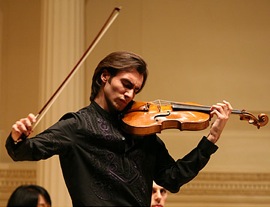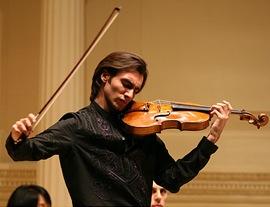Yes, viola; yes, all 20th-century; no, hardly at all atonal.

Rebecca Clarke’s 1919 Sonata, which formed the backbone of this long and demanding program, by this point ought to need no introduction. Clarke, a violist and a composer, wrote few big pieces — this and a piano trio from a couple of years later are about it — yet what she did, she did very well indeed. The Sonata famously tied for first place with Ernst Bloch’s Suite in a competition sponsored by Elizabeth Sprague Coolidge, who cast the tie-breaking vote for the Bloch, but was enchanted to learn that the second-place piece was written by a woman.
The Clarke Sonata really has no parallels in the viola or (indeed) the violin literature. The style is more Franco-Belgian than anything else; the second-movement scherzo shimmers and dazzles like Ravel. But then there’s a vein of English pastoralism, a whiff of internalized folk song, that anchors the last movement, especially, firmly to England. It has every virtue you could want in a big piece for viola, starting with variety of mood: You have to scamper and to sing, to brood and to dance and then to croon in a hushed voice. Carpenter did it all, especially the last, with the sort of skill that stops hearts. And his pianist, Julien Quentin, was brilliant here, as he was throughout the afternoon, throwing off such sparks in the middle movement that you momentarily forgot whose recital it was.
York Bowen’s Op. 54 Phantasy, which opened the recital, is a much rarer item than the Clarke. Bowen, also himself a violist, wrote a pile of music for the instrument, but this is the first time I’ve run across this work. It starts, indeed, very like the last movement of the Clarke that followed it: low, sweet, and modal. Within a couple of minutes, though, there’s mayhem to spare — and a minute or so after that, the sort of tune no string player can help but salivate over. Admittedly, after that point, the piece takes its “phantasy” dedication almost too literally, and often won’t stay in one character long enough for you to enjoy it. Still, there’s a long, lyrical episode in D-flat some distance in that is borderline-irresistible, followed by a fast final section with lots of doubled notes that maybe isn’t in the best of taste, but sure does rock.
Climbing to Craggy Heights
The second, non-English half of the recital was craggier. Krzysztov Penderecki’s Cadenza for solo viola proved to be just what the title implied. The work starts slowly and softly, with stylized sighs; from there it rockets up rapidly to fierce activity and many harsh double-stops, flying all over the place before dropping to the point at which it started. Penderecki is one of those composers who can’t quite please anyone; there are those who can’t stand his later “Neo-Romantic” stuff, and those who, on the other hand, can’t stand the earlier hyper-noisy stuff (the Auschwitz Oratorio and like works) that made his Western reputation. This is a piece from 1984, so well into the “Neo-Romantic” period; I have to say that I liked it very much. (If you want to hear a viola torn into small pieces, there’s always Berio’s Sequenza VI, or the “raging tempo” movement from Hindemith’s Op. 25/1.)Vadim Borissovsky’s transcriptions of movements from Prokofiev’s Romeo and Juliet would be better known here if the copyright situation were clearer. It’s actually still a little unclear, and I’ve seen a number of editions appear and then vanish as the legalities asserted themselves.
The music, of course, is scrumptious; and Borissovsky picked his numbers with great discretion. (He didn’t worry overmuch, though, about tracking the story literally, which is how “Mercutio” happens to follow “The Death of Juliet.”)
And Astor Piazzolla’s piece Le Grand Tango rounded the program out. That is, of course, ordinarily cello material. But it makes a fabulous viola showpiece played with this sort of swagger, this degree of bite and tautness and rhythmic attitude in the bowing.
Throughout the program, Carpenter played as though he had no idea he ought to worry about being overbalanced by the lid-full-up piano. He needn’t have worried at all. I’m not sure what miracle of a viola he has use of, but it’s simultaneously small, sonorous, and wolfless. (Wolfs are pesky resonances on stringed instruments that growl if you so much as look at them; they represent the acoustic compromise you’re stuck with if you play anything tuned lower than it should be, like any viola not big enough to maim your hands.)
It’s a cocky violist indeed who makes the William Primrose arrangement of Paganini’s La Campanella his second encore. (The first was Rachmaninov’s Vocalise, predictably silky and suave.) The last time Carpenter was here, La Campanella was on the printed program. Neither then nor Sunday was he quite in a position to match Primrose’s own scary level of facility. Yet Carpenter threw himself into the lyricism of the piece in a way that made me listen more to the tunes than to the pyrotechnics. What stood out were the gorgeously shaded, nearly-vocal melodic lines. The man sings through his instrument, in a way that few of his colleagues can.
I like to see “stupid viola tricks” as much as the next viola player; it’s a pleasure to witness someone doing things on the instrument that really ought not to be possible. But the reason I myself play it is for the sound; and Carpenter clearly loves the sound above all. I hope he returns soon.

